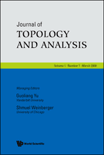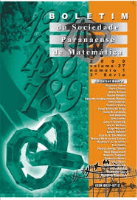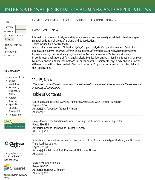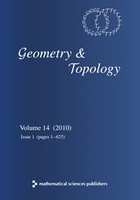
Journal of Fixed Point Theory and Applications
Scope & Guideline
Driving Discovery in the Heart of Basel's Academic Community.
Introduction
Aims and Scopes
- Fixed Point Theory:
The journal extensively covers the theoretical aspects of fixed point theory, particularly focusing on the existence, uniqueness, and multiplicity of fixed points in various mathematical structures. - Nonlinear Analysis:
Papers often explore nonlinear differential equations, variational problems, and boundary value problems, showcasing the application of fixed point methods to solve complex nonlinear systems. - Topological and Geometric Applications:
The journal addresses the interplay between topology, geometry, and fixed point theory, emphasizing applications in areas such as symplectic geometry, manifolds, and algebraic topology. - Stochastic and Random Processes:
Research on fixed points in stochastic systems and their applications in control theory and differential equations is a significant focus, demonstrating the versatility of fixed point techniques. - Methodological Innovations:
The journal promotes novel methodologies and techniques in fixed point theory, including iterative methods, contraction principles, and topological degree theory, contributing to the advancement of mathematical tools.
Trending and Emerging
- Nonlocal and Fractional Differential Equations:
There is a growing interest in the application of fixed point theory to nonlocal and fractional differential equations, reflecting a broader trend towards exploring complex systems that deviate from classical local behavior. - Computational Fixed Point Methods:
The integration of computational techniques in fixed point theory is increasingly prominent, with papers focusing on numerical methods and algorithms for approximating fixed points in various applications. - Dynamical Systems and Stability Analysis:
Research on the stability of solutions in dynamical systems using fixed point approaches is gaining traction, indicating a shift towards understanding the behavior of solutions over time rather than in static contexts. - Multi-valued and Set-Valued Mappings:
The exploration of fixed points in the context of multi-valued and set-valued mappings is on the rise, reflecting the complex nature of modern mathematical problems and the need for generalized solutions. - Applications in Physics and Engineering:
The application of fixed point theory in physical and engineering contexts, particularly in areas such as control systems and fluid dynamics, is becoming increasingly prevalent, bridging theoretical mathematics with practical applications.
Declining or Waning
- Classical Fixed Point Theorems:
Traditional fixed point theorems, such as the Brouwer and Banach fixed point theorems, have been less frequently addressed in recent papers, as the focus shifts towards more complex and generalized settings. - Linear Functional Equations:
Research centered on linear functional equations and their fixed point properties appears to be diminishing, with fewer studies exploring this classical area compared to more contemporary nonlinear applications. - Static Systems:
There has been a noticeable reduction in papers focusing on static systems and their fixed points, with a growing trend towards dynamic and time-dependent systems in the current research landscape.
Similar Journals

Tamkang Journal of Mathematics
Illuminating the Path of Mathematics in Science and BeyondTamkang Journal of Mathematics, published by TAMKANG UNIVERSITY, serves as a vital platform for researchers and professionals in the fields of applied mathematics, general mathematics, and materials science. With an ISSN of 0049-2930 and an E-ISSN of 2073-9826, this journal has established itself within the academic community, particularly noted for its contributions from Taiwan. Although categorized as Q4 in Applied Mathematics and Q3 in multiple related fields according to the 2023 ranking, it maintains a solid reputation for disseminating significant research findings and innovative methodologies. Researchers can explore an array of topics within its pages, making it an excellent resource for enhancing mathematical knowledge and applications. As it converges from 2005 to 2024, the journal invites academics, professionals, and students to engage with its content and contribute to the ongoing dialogue in mathematics and its interdisciplinary applications.

Journal of Topology and Analysis
Shaping the Future of Topological ResearchJournal of Topology and Analysis, published by WORLD SCIENTIFIC PUBL CO PTE LTD, is a distinguished peer-reviewed journal that focuses on advanced topics in mathematics, specifically within the fields of topology and analysis. Established in 2009 and running through 2024, the journal is based in Singapore and strives to present cutting-edge research that contributes to the mathematical community's understanding of geometric structures and analytical theories. Holding a respected position with a Q2 ranking in Analysis and a Q3 ranking in Geometry and Topology according to the 2023 category quartiles, the journal is indexed in Scopus, where it ranks #49 in Geometry and Topology and #118 in Analysis, showcasing its significance in the scholarly landscape. The Journal of Topology and Analysis aims to foster interdisciplinary collaboration by providing a platform for researchers, professionals, and students to share innovative findings and insights. Although it does not currently offer open access, its contributions are vital for advancing knowledge in these mathematical domains.

Revista Matematica Complutense
Elevating Academic Dialogue in MathematicsRevista Matematica Complutense is a prestigious peer-reviewed journal published by SPRINGER-VERLAG ITALIA SRL, specializing in the field of mathematics. With its ISSN 1139-1138 and E-ISSN 1988-2807, the journal plays a vital role in disseminating high-quality research and fostering academic discussion within the mathematics community. Recognized for its rigorous selection process, the journal has achieved impressive rankings, holding a Q1 quartile status in the miscellaneous mathematics category as of 2023 and ranking #94 out of 399 in general mathematics according to Scopus, placing it within the 76th percentile. With a publication timeline spanning from 2008 to 2024, the Revista Matematica Complutense continues to serve as an essential resource for researchers, professionals, and students alike. Although it does not currently offer open access, the journal remains committed to advancing mathematical knowledge and providing a platform for innovative research across various mathematical disciplines.

Matematicki Vesnik
Exploring the frontiers of mathematics with every issue.Matematicki Vesnik is a distinguished open-access journal published by the MATH SOC SERBIA-DRUSTVO MATEMATICARA SRBIJE, dedicated to advancing the field of mathematics since its inception. With an ISSN of 0025-5165 and an E-ISSN of 2406-0682, this journal has been a significant platform for disseminating research findings since its establishment in 1993. Hosted in Serbia, it embraces a broad scope of mathematical discourse while achieving a Q3 category ranking in miscellaneous mathematics for 2023. As part of its commitment to fostering scholarly communication, Matematicki Vesnik is accessible to a global audience, promoting high-quality research and innovative ideas within the mathematical community. With converged years from 1999 to 2024 and a Scopus rank of #232 out of 399 in General Mathematics, the journal plays a crucial role in enhancing visibility and impact for researchers, professionals, and students alike in the dynamic landscape of mathematical inquiry.

Boletim Sociedade Paranaense de Matematica
Unlocking the Future of Mathematical InquiryBoletim Sociedade Paranaense de Matematica is a distinguished journal within the field of Mathematics, published by the Sociedade Paranaense de Matemática in Brazil. With an ISSN of 0037-8712 and an E-ISSN of 2175-1188, this journal has been committed to fostering open access to mathematical research since 2002, ensuring that cutting-edge research is readily available to the academic community. Operating within the diverse landscape of mathematical studies and ranked Q3 for 2023 in the category of Mathematics (Miscellaneous), the journal serves as a platform for innovative contributions and discussions. It ranks 192nd out of 399 in the Scopus database for General Mathematics, reflecting its steady involvement in the global academic dialogue. The Boletim resides at JD AMERICAS, CAIXA POSTAL 19081, CURITIBA PR 81531-990, Brazil, and aims to connect researchers, practitioners, and students by promoting high-quality research and dissemination of mathematical knowledge. By bridging diverse mathematical theories and applications, the journal not only enhances understanding of the discipline but also drives future research directions.

Korean Journal of Mathematics
Bridging Theory and Application in Mathematics.The Korean Journal of Mathematics, published by the Kangwon-Kyungki Mathematical Society, is an esteemed platform dedicated to advancing the field of mathematics. With an ISSN of 1976-8605 and E-ISSN of 2288-1433, the journal features a range of scholarly articles that emphasize both theoretical and applied aspects of mathematics, catering to researchers, professionals, and students alike. Although it is not open access, the journal maintains a commitment to academic rigor and integrity, ensuring high-quality contributions to the mathematical community. As it converges from years 2021 to 2024, the Korean Journal of Mathematics is poised to enhance its visibility within the Scopus database, currently ranking #354 out of 399 in the general mathematics category, reflecting its potential for growth and impact in the mathematical sciences. With its strategic focus and institutional backing from Kangwon National University, the journal serves as a vital resource for fostering research and dialogue in the ever-evolving landscape of mathematics.

Electronic Journal of Qualitative Theory of Differential Equations
Exploring the Depths of Differential EquationsThe Electronic Journal of Qualitative Theory of Differential Equations, published by the esteemed UNIV SZEGED's BOLYAI INSTITUTE in Hungary, is a prominent platform in the realm of applied mathematics, recognized for its rich contributions to the field since its inception in 1998. With an ISSN of 1417-3875 and open access format, the journal ensures that cutting-edge research is accessible to a global audience, fostering collaboration and knowledge exchange among researchers, professionals, and students alike. It holds a commendable Q2 ranking in Applied Mathematics, reflecting its commitment to high-quality scholarship, and maintains a respectable Scopus rank, positioned at #432 out of 635. Covering a wide spectrum of qualitative theories related to differential equations, the journal guides its readers through the complexities of mathematical theories and applications, making it an essential resource for anyone looking to deepen their understanding in this vital area of study. The journal's focus on innovative and interdisciplinary approaches ensures that it remains at the forefront of mathematical research, ultimately contributing to advancements in the field.

NONLINEAR ANALYSIS-THEORY METHODS & APPLICATIONS
Fostering Excellence in Nonlinear Research and ApplicationNONLINEAR ANALYSIS-THEORY METHODS & APPLICATIONS, published by PERGAMON-ELSEVIER SCIENCE LTD in the United Kingdom, is a premier journal that has been advancing the field of nonlinear analysis since its inception in 1976. This esteemed journal has a commendable impact factor, reflecting its crucial role in disseminating high-quality research in Analysis and Applied Mathematics, having achieved Q1 rankings in both categories for 2023. With an impressive Scopus ranking of #36 out of 193 in Mathematics-Analysis and #194 out of 635 in Mathematics-Applied Mathematics, it provides a platform for groundbreaking studies that push the boundaries of theoretical and applied methodologies. Although it operates through a subscription model, the journal’s comprehensive content serves as an invaluable resource for researchers, professionals, and students alike, contributing to the ongoing dialogue in the field and fostering advancements in technology and science.

International Journal of Analysis and Applications
Bridging theory and practice in analysis and applications.International Journal of Analysis and Applications, published by ETAMATHS PUBL, is a premier open-access journal dedicated to fostering advancements in the fields of analysis, applied mathematics, geometry, topology, and their applications in business and international management. With a commitment to providing high-quality research, the journal has been an open-access platform since 2013, ensuring that researchers, professionals, and students have unhindered access to valuable findings and methodologies. Based in Vancouver, Canada, the journal’s scope spans a diverse range of mathematical disciplines, bridging theoretical concepts with practical applications. The journal has been categorized in various quartiles as of 2023, reaching Q4 in Analysis and Applied Mathematics, and Q3 in Business and International Management, highlighting its growing importance in the academic community. At present, it is ranked 55th in Geometry and Topology and holds a respectable position within the Scopus database. By fostering innovative research and providing a collaborative platform, the International Journal of Analysis and Applications aims to contribute significantly to the development and application of mathematical theory in contemporary settings.

GEOMETRY & TOPOLOGY
Exploring the Boundaries of Mathematical ThoughtGeometry & Topology is a leading journal in the field of mathematics, focusing on the intricate relationships between geometric structures and topological spaces. Published by Geometry & Topology Publications in the United Kingdom, this prestigious journal boasts an impressive ranking, placing it in the Q1 quartile for Geometry and Topology as of 2023, with a notable Scopus rank of #13 out of 106, indicating its significant impact within the discipline (88th percentile). With publication years spanning from 1997 to 2024, the journal serves as a vital platform for disseminating high-quality research, fostering advances in both theoretical and applied aspects of the field. While it does not currently operate under an Open Access model, it nevertheless attracts the attention of a diverse audience, including researchers, academics, and students eager to explore innovative methodologies and findings in geometry and topology. The journal’s commitment to excellence makes it an essential resource for anyone passionate about mathematical research.